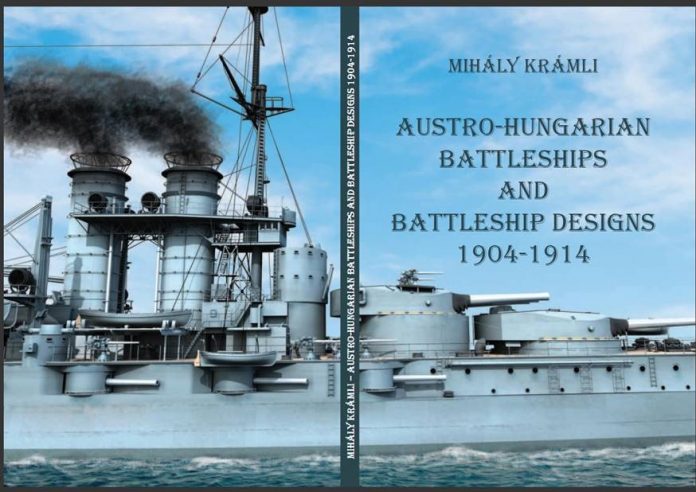
Austro Hungarian Battleships and Battleship Designs 1904 1914. Mihály Krámli, Belvedere Meridionale, Szeged, 2021, 195pp, ISBN 978-615-6060-43-3
Reviewed by Mark Bailey PhD
This is a highly unusual, uniquely valuable and very well-illustrated work. The book is of high quality in most respects. It is well printed on high quality stock, with clear, high quality black-and-white photographs. The great majority of these will be new to ANI members as they are from Hungarian sources and have not before been published in English-language publications. The only point to be raised on the quality of the publication is that the softcovers are somewhat too light: they can easily be damaged. They make up for this with an excellent 3D computer visualisation of SMS Szent Istvan.
Even better are the numerous and clear diagrams, such as those of the never-built improved Tegetthoff design. The array of diagrams is impressive: where images of original diagrams from historic files are used (such as those of the ‘Sprengobjekt’, a full scale test piece for the improved Tegetthoff design torpedo protection system) they are of lesser quality, but this merely reflects the state of the original document as imaged. They are still quite clear. Where new diagrams have been commissioned (such as for the details of the Tegetthoff class triple turrets and loading systems) they are of excellent quality.
The author, Mihály Krámli, provides a good summary of the background, covering the Imperial and Royal Navy, Austro-Hungarian naval industry and the arms race with Italy. The Radetzky class battleships are covered in detail. This includes five pages of the ship’s plans, photo-reduced greatly in scale (the originals being 6-7 feet long). As is usual, this compression makes much of the written annotation too small to read and ‘washes out’ the contrast where the original document has faded. However, as is also usual these diagrams are mostly legible with bright lighting and a magnifying glass or reading lamp and still form a valuable resource. Where else are you going to obtain such data? Coverage of the Tegetthoff class design and construction is in even more depth, and includes the reports of their initial commanding officers. The loss of Szent Istvan is covered in detail and includes pages of fine detail of the occurrences inside the ship, ranging from men hearing the death cries of the 7cm magazine crews just after the torpedoes hit to details of the efforts of the damage control crews to fight the progressive flooding which sank the ship. The subsequent travails of the survivors and the court of inquiry are also covered.
It is here where the author’s research really shines. Krámli provides a well-balanced selection of the human face of the KuK Marine through careful use of survivors reports, private letters and reminiscences. While not social history, this provides a ‘look inside the ships’ of the KuK Marine which is just otherwise unobtainable in English.
The never-built improved Tegetthoff design is also covered using the same methodology. The final chapters cover gunnery and fire control and are again most informative.
There are 612 endnotes for this 192-page volume, the bulk of which reference primary sources. This speaks highly of the depth of the author’s research. ANI members will find the book to be slightly ‘clunky’ to read in places, as the book has been translated from the Hungarian in which it was written. The occasional grammatical oddity does not detract from the clarity of expression or value of the book in any way.
This book is, to date, unique. ANI members with even a passing interest in what is obscure in English, in WWI in the Adriatic, or in the KuK Marine will find this book to be a real must-have. I have all of these interests and found that Austro Hungarian Battleships and Battleship Designs 1904 1914 exponentially increased my knowledge of how and why the KuK Marine fought its war the way it did. I ascribe this to it being an account ‘from the inside looking out’ which was also intended (in its original Hungarian) to tell a land-locked nation of the Navy which once fought for it. I also recommend this book to anyone interested in WWI naval technology or the first generation of battleships.
Now for the big question, how do you get a copy? It is not for sale by any of the usual means. You have to buy it from the author, who still has access to a small stock of the English-language variant. The work was printed with the financial support of the Foundation for Hungarian Military Historiography: it is not a private publication, but a limited-run and modified translation of the original work in Hungarian.
Therefore, send the author, Mihály Krámli, an email at kramlimi@gmail.com
The cost is US$40.00. Now, that might raise an eyebrow, but most of that is due to the high EU postage costs (over half of the total price). Mihály has set up a PayPal account for Australian buyers due to the difficulty of EFT between Australia and Hungary. I was able to receive my copy in 17 days, not bad considering the current disruptions to international postage and trade.



